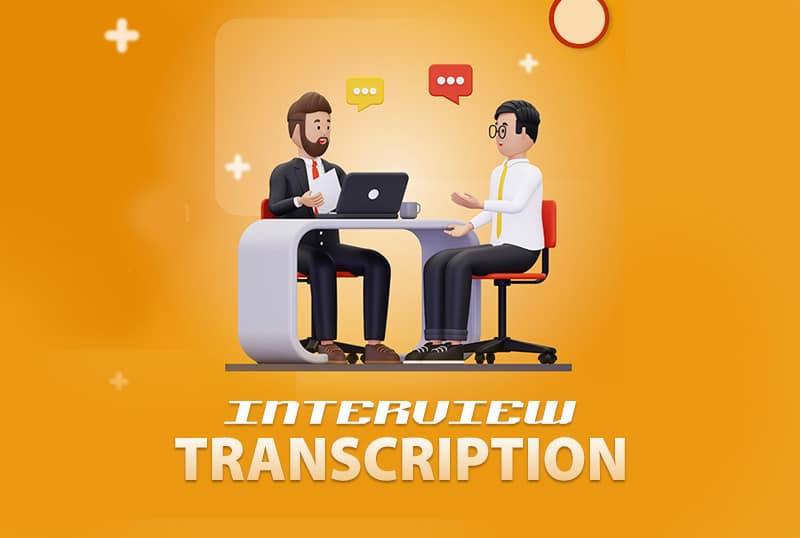You can record an interview to preserve the conversation’s discourse and specifics for later use. The transcription of an interview can be done in real time or after it has been recorded, by watching, listening, and typing it down. The dialogue will be captured in text via the transcript, which is useful for future reference and to build a text-based searchable database. A trustworthy interview transcription service aids in accurately transcribing any interview into a document format.
Importance of Interview Transcription
For anyone who conducts interviews, interview transcription is a useful service. It is frequently used in fields such as law enforcement, academia, law, insurance, and business management to schedule interviews, and to get accurate notes for work, court documents, and hiring procedures. Transcribing your interviews is an excellent option if you want to enhance your interviewing abilities or make a written record of a significant session.
For busy professionals who conduct interviews frequently, interview transcripts have a number of advantages. Getting interviews transcribed can be a difficult, time-consuming process that demands a lot of planning and organization. A lot of notes from these interviews are also produced, which can make them challenging to organize and use. You will be able to remember every detail of the talk by transcribing interviews.
Reasons to Transcribe Interviews
- Boost your interview skills: The ability to conduct interviews more effectively is a major motivation to have interviews transcribed. A transcript, for instance, will alert you if you have repeatedly used filler words, “Well, that’s terrific,” etc. during an interview. Despite the fact that these statements are motivating, they break the candidate’s flow. You might also get the option to evaluate the interviewee’s responses to the questions you ask.
- Actionable Information: Important information can be easily retrieved and transformed into useful material using an interview transcript. Business professionals, for instance, can use the written data from the interview’s transcript to create workable strategies and follow-ups for team members. A transcript also gives you the chance to use precise excerpts from the interview in marketing materials like testimonials.
- Make your research objective: After a few interviews, if a particular pattern starts to show up, you run the danger of missing other crucial results. Due to biased attention, you might even overhear some statements when listening to the interview again. It may be possible to increase the objectivity of your research through the analysis of a transcript and written material, which is another form of communication. For instance, a systematic analysis of user comments reveals if your theories about a fascinating new feature are true or whether you unconsciously gave more weight to the positive comments.
- Promote collaboration: It makes sense to allow several researchers to examine the raw data in order to prevent interviewer bias. However, watching a video with coworkers requires a lot of work, especially if you are not in the same place. A transcript typically has a smaller file size, can be shared fast, and may be modified and highlighted using any text editor, such as Google Docs or Microsoft Word. A textual representation enables you to categorize facts and link them to insights collaboratively in a text document quickly (and without the need for specific tools). As a result, your research findings are simply shared and presented because they are directly documented.
- Keep your research accurate: When you make a transcript, you are able to focus on the facts. You don’t have to worry about what you wrote down or be concerned about misremembering something. You will be able to perfectly recall all aspects of the interview. This will help you stay accurate and adhere to standard qualitative research protocols. Even better, you will be able to cut and paste quotes for accuracy, prove your point more concisely, and provide context for your findings. You can even mark up a copy of the transcript with your own thoughts, conclusions, and highlight gaps in your research.
- Ensures accuracy: Scholars and journalists require a transcript of the interviews to get reliable information. To properly format your research report, you might need to include a verbatim quote from the interviewee. You must be completely accurate in this circumstance regarding both the context and the exact words used. This may not be possible while listening to the audio. Also, you cannot draw attention to the precise setting in which an interviewee made a given statement.
- Spend less time on the assessment: Replaying all of those films or audio files may take a while. To find specific passages and obtain the appropriate quotes and highlights, you must navigate back and forth. You can scan the interview’s contents more quickly with the aid of a transcript that includes timestamps. You can use keywords to search the text, find the timestamp, and then navigate right to that spot. A transcript also makes it easier to include important quotes in your reports because you can just copy and paste what was stated. A highlight video is a common product used to share research findings. Here, the key points are highlighted without subjecting the language or tone of voice to the researcher. Sentences that have been marked in a transcript can be used as input for that.
- Produce better reports: There are new choices for reporting as a result of the expanded evaluation options. By giving them more information, you can help them understand your insights better. Your reports will have greater weight if you combine quantitative analysis with qualitative data, such as verbatims and video clips. You now have a whole new range of opportunities to use data to support your conclusions after conducting a transcript analysis.
For individuals who have no prior expertise with transcribing, interview transcription takes a lot of time. It can be challenging to quickly and accurately transcribe interviews while overcoming obstacles such as poor audio quality or speaker crosstalk without the right training and equipment. An interview transcript needs persistence, attentive listening, and meticulous editing. As a result, it is recommended to outsource interview transcription to a trustworthy provider. Regular interviewers should avoid manually transcribing meetings because it is ineffective and time-consuming. Due to their hectic schedules, many professionals choose to outsource interview transcription to reliable providers of interview transcription services in order to entrust those who can produce accurate, legible, and high-quality transcripts in a timely manner. Transcriptionists can deliver high-quality work in a timely and cost-effective manner because they have the skill and experience to do so.




